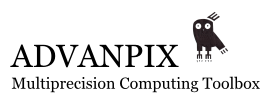![]() Hi there from sunny Japan!
Hi there from sunny Japan!
I am ..erm.., well, it is hard to describe with one word. There are so many criteria on how to define a person – by education, experience, occupation, career, family, hobby, likes, dislikes, etc. I do not want to bore you with all of that, so here are just some bits of info about me.
I love to create things, to solve important and practical tasks and to develop end-user products based on derived solution.
Major fields I’m interested in: numerical computing, digital filter design and image processing, time series analysis and prediction, machine learning, artificial intelligence (whatever this means), system identification and control.
My tools:
- C/C++
- Language(s) of all languages. Fast development, best run-time performance, low CO2 emission. I’ve been moving towards generic meta-programming lately (expression templates and alike). Qt, Boost and Eigen are my weapon of choice.
- Maple
- I’ve been using it since 1997. Algorithms behind it are great, but its unskillful implementation drives me crazy. UI is written in Java – the worst thing which could happen to the software. I heard Maple development costs $100 million a year. Well, my team can do it for the half price with much better quality. Let me know if you are interested ;).
- MATLAB
- I like the idea – to make numerical methods accessible by wrapping them with simple language. High abstraction level in action, as C++ programmer inside me would say. Last time I checked MATLAB’s price was around $4000 for independent researcher with minimum set of toolboxes. Such ridiculous prices are harmful for MATLAB itself – it was only question of time for open source alternatives to appear (of bad quality though).
Projects I am particularly proud of:
Extension for MATLAB which allows computing with arbitrary precision. It uses classic OOP techniques (like operator overloading) for tight integration with MATLAB language & environment. As a result multiprecision numbers and matrices can be used interchangeably with built-in objects of limited precision. This makes possible to run existing scripts with any desired precision without modifications to code.
 Creation of image compression technique which made possible image transmission through very low-bandwidth radio connection. A lot of such systems in Japan were installed in 80-ies for voice/text transmission. Situation has changed radically in that niche since introduction of image transmission capability. Algorithm quickly became de-facto standard for image transmission in the field. Japanese major vendors (NEC, Fujitsu, Hitachi, OKI, Matsushita, JRC) support the technology and have implemented it in many real-world applications. One kind of applications I particularly proud of – disaster prevention systems. I hope my work will help to save someone’s life someday. Company I worked for issued several patents related to this technology (2007-49594, 2007-133678).
Creation of image compression technique which made possible image transmission through very low-bandwidth radio connection. A lot of such systems in Japan were installed in 80-ies for voice/text transmission. Situation has changed radically in that niche since introduction of image transmission capability. Algorithm quickly became de-facto standard for image transmission in the field. Japanese major vendors (NEC, Fujitsu, Hitachi, OKI, Matsushita, JRC) support the technology and have implemented it in many real-world applications. One kind of applications I particularly proud of – disaster prevention systems. I hope my work will help to save someone’s life someday. Company I worked for issued several patents related to this technology (2007-49594, 2007-133678).
 Creation of image compression algorithm for wireless Endoscopic system of capsule type. That was the most challenging project ordered by R&D department of Olympus. They wanted to abandon JPEG because of blocking artifact but preserve JPEG’s block-by-block encoding pipeline. And they wanted to improve compression ratio in the same time! That was fun year for me. Olympus applied for 4 patents based on this work. (I have no idea about the destiny of this project in Olympus though, link is for old version of the product).
Creation of image compression algorithm for wireless Endoscopic system of capsule type. That was the most challenging project ordered by R&D department of Olympus. They wanted to abandon JPEG because of blocking artifact but preserve JPEG’s block-by-block encoding pipeline. And they wanted to improve compression ratio in the same time! That was fun year for me. Olympus applied for 4 patents based on this work. (I have no idea about the destiny of this project in Olympus though, link is for old version of the product).To be continued (no promises) ……
With comments, suggestions, proposals and job offers please contact me by e-mail: pavel@holoborodko.com


 (104 votes, average: 4.64)
(104 votes, average: 4.64)